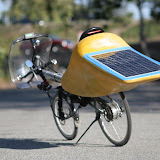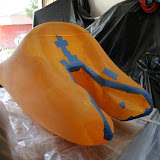What is the solar panel for?
Would you believe it's for charging my iPod? Mostly it's charging a battery that runs a motor. Think human-electric hybrid. On long trips, I only use it for extra help up hills. On short trips, I use it to boost my speed and reduce pedaling effort. Imagine commuting 10 miles without breaking a sweat. Imagine riding a bike which pulls its own weight up hills so that it feels weightless.
Do you really have to pedal?
While it's possible to ride shorter distances on flat ground without pedaling, I wouldn't want to. I started this project because I like cycling but I don't like climbing steep hills. This is still a bicycle. If I didn't want to pedal, I would have built a solar electric scooter.
Did you build it yourself?
Yes and no. The bike frame is an HP Velotechnik Street Machine GTe touring recumbent. Most of the other components, like the motor kit, are off-the-shelf items. The lightweight, aerodynamic solar electric module is a one of a kind custom job I designed and built.
Can you charge the batteries while pedaling?
I get this one a lot. In theory, it is possible. In reality, it takes a lot of effort to generate a useful amount of electricity. Imagine riding a bike with the brakes on all the time. How fun would that be?
But what about regenerative breaking down hills and in stop-and-go traffic?
Regenerative braking (using the motor as brakes and using the generated energy to charge the batteries) has attained near-mythical status as a source of free, non-polluting energy. It's like the Holy Grail of energy conservation. Regenerative braking makes sense on an electric car because a car is heavy and has a lot of momentum. Because a bicycle is so much lighter, regenerative braking would only add 2-3% to the battery's range.
The added cost and weight simply aren't justified. In my case, I'm using a mid-drive motor with a freewheel on it which allows me to pedal without using the motor or motor without pedaling or do both at the same time. It's a very efficient, safe set-up and has very little motor drag when pedaling. However, the wheels cannot turn the motor. To add regenerative braking I would have to change to a completely different drive system where the motor is integrated into the wheel hub.
BionX makes an electric bike conversion kit with a regenerative braking option. It's easier to implement this on a hub motor rather than the mid-drive motor I'm using. For the technically-minded, here's a great article with lots of numbers for a more comprehensive analysis: Regenerative braking and electric bicycles (PDF) .
What's with the funny looking bike?
Oh, the recumbent? In the earliest days of this design, I envisioned a large, flat solar panel with the rider sitting in a hole in the middle. Here's a sketch of that idea. I though I would need a low, stable three-wheeled platform to carry such a large panel. I figured the panel would need to be that big because I read that a cyclist uses 100 to 200 watts of energy while pedaling and I imagined being able to cruise all day without getting tired. I have since figured out that I don't need a 200 watt panel but that I do need a battery. The panel placement and design have undergone a least a hundred changes since the start of this project. Eventually, I may build a custom bike using carbon fiber composite construction to make it lighter.
How fast can it go?
- 52 mph (84 km/h) top speed coasting downhill
- 15-30 mph (24-48 km/h) pedaling with power assist on flat ground
- 20 mph (32 km/h) batteries driving motor, flat ground, no pedaling (this is the legal limit in California)
- 8 mph (13 km/h) projected top speed on solar power alone in full sun, no batteries, no pedaling
What's the range?
- 34 miles (55 km) on a full charge using just the batteries
- 20-25 miles (30-40 km) a day on solar power with my current solar module (cloudless day in Northern California in May)
- 40-60 miles (65-95 km) a day on solar power after I finish my next module
- Up to 150 miles (240 km) a day starting with full batteries, given ideal sun conditions all day between June and August with my current 40 watt module in the rear and a second 60 watt module in the front (under construction). All of these numbers assume mostly flat terrain. Hill climbing can cut all of these numbers in half.
Are you an engineer?
Nope. Would you believe first semester engineering school drop-out? Basically, I'm just stubborn. I refuse to believe it couldn't be done.
How much did it cost?
About US$ 0.25/mile, assuming it lasts 20,000 miles. I have put 3,100 miles on it so far. Put another way, I've spent enough on research and development to buy two or three really nice carbon fiber road bikes.Don't see your question here? Drop me a note in the comments.


